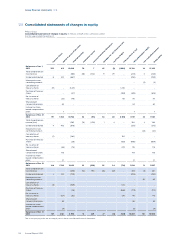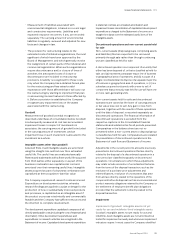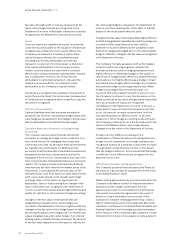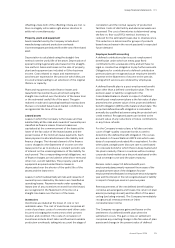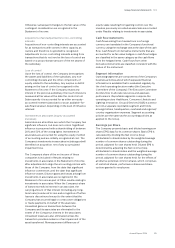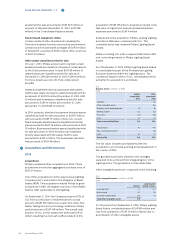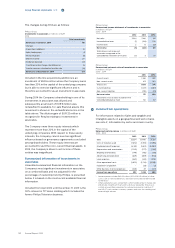Philips 2014 Annual Report Download - page 123
Download and view the complete annual report
Please find page 123 of the 2014 Philips annual report below. You can navigate through the pages in the report by either clicking on the pages listed below, or by using the keyword search tool below to find specific information within the annual report.Group nancial statements 12.9
Annual Report 2014 123
osetting unless both of the osetting criteria are met, i.e.
there is a legally enforceable right and an intention to
settle net or simultaneously.
Property, plant and equipment
Assets manufactured by the Company include direct
manufacturing costs and production overheads.
Government grants are deducted from the cost of the related
asset.
Depreciation is calculated using the straight-line
method over the useful life of the asset. Depreciation of
special tooling is generally also based on the straight-
line method. Gains and losses on the sale of property,
plant and equipment are included in Other business
income. Costs related to repair and maintenance
activities are expensed in the period in which they are
incurred unless leading to an extension of the original
lifetime or capacity.
Plant and equipment under nance leases and
leasehold improvements are amortized using the
straight-line method over the shorter of the lease term
or the estimated useful life of the asset. The gain
realized on sale and operating leaseback transactions
that are concluded based upon market conditions is
recognized at the time of the sale.
Leased assets
Leases in which the Company is the lessee and has
substantially all the risks and rewards of ownership are
classied as nance leases. Finance leases are
capitalized at the commencement of the lease at the
lower of the fair value of the leased assets and the
present value of the minimum lease payments. Each
lease payment is allocated between the liability and
nance charges. The interest element of the nance
cost is charged to the Statement of income over the
lease period so as to produce a constant periodic rate
of interest on the remaining balance of the liability for
each period. The corresponding rental obligations, net
of nance charges, are included in other short-term and
other non-current liabilities. The property, plant and
equipment acquired under nance leases is
depreciated over the shorter of the useful life of the
assets and the lease term.
Leases in which substantially all risks and rewards of
ownership are retained by the lessor are classied as
operating leases. Payments made under operating
leases (net of any incentives received from the lessor)
are recognized in the Statement of income on a
straight-line basis over the term of the lease.
Inventories
Inventories are stated at the lower of cost or net
realizable value. The cost of inventories comprises all
costs of purchase, costs of conversion and other costs
incurred in bringing the inventories to their present
location and condition. The costs of conversion of
inventories include direct labor and xed and variable
production overheads, taking into account the stage of
completion and the normal capacity of production
facilities. Costs of idle facility and abnormal waste are
expensed. The cost of inventories is determined using
the rst-in, rst-out (FIFO) method. Inventory is
reduced for the estimated losses due to obsolescence.
This reduction is determined for groups of products
based on purchases in the recent past and/or expected
future demand.
Employee benet accounting
A dened contribution plan is a post-employment
benet plan under which an entity pays xed
contributions into a separate entity and will have no
legal or constructive obligation to pay further amounts.
Obligations for contributions to dened contribution
pension plans are recognized as an employee benet
expense in the Statement of income in the periods
during which services are rendered by employees.
A dened benet plan is a post-employment benet
plan other than a dened contribution plan. The net
pension asset or liability recognized in the
Consolidated balance sheets in respect of dened
benet post-employment plans is the fair value of plan
assets less the present value of the projected dened
benet obligation (DBO) at the balance sheet date. The
projected dened benet obligation is calculated
annually by qualied actuaries using the projected unit
credit method. Recognized assets are limited to the
present value of any reductions in future contributions
or any future refunds.
For the Company’s major plans, a full discount rate
curve of high-quality corporate bonds is used to
determine the dened benet obligation. The curves
are based on Towers Watson’s RATE:Link which uses
data of corporate bonds rated AA or equivalent. For the
other plans a single point discount rate is used based
on corporate bonds for which there is deep market and
the plan’s maturity. Plans in countries without a deep
corporate bond market use a discount rate based on the
local sovereign curve and the plan’s maturity.
Pension costs in respect of defined benefit post-
employment plans primarily represent the increase of the
actuarial present value of the obligation for post-
employment benefits based on employee service during the
year and the interest on the net recognized asset or liability
in respect of employee service in previous years.
Remeasurements of the net dened benet liability
comprise actuarial gains and losses, the return on plan
assets (excluding interest) and the eect of the asset
ceiling (excluding interest). The Company immediately
recognizes all remeasurements in Other
comprehensive income.
The Company recognizes gains and losses on the
settlement of a dened benet plan when the
settlement occurs. The gain or loss on settlement
comprises any resulting change in the fair value of plan
assets and change in the present value of dened



